#Brongniart
Photo
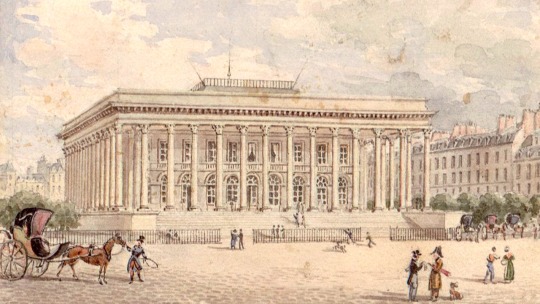
24 mars 1808 : pose de la première pierre de la Bourse, à Paris ➽ http://bit.ly/Construction-Bourse-Paris Malgré l’ordonnance de 1563 et l’arrêt du conseil du 24 septembre 1724, Paris n’avait point encore, d’une manière définitive et au début du XIXe siècle, sa Bourse, sa « loge de la Marchandise », comme en possédaient alors déjà Amsterdam, Venise, Londres, Saint-Pétersbourg, Vicence, Padoue, Brescia et les principales villes commerçantes de l’Europe
#CeJourLà#24Mars#Bourse#Paris#Palais#Architecte#Brongniart#Édifice#Monument#Construction#Édification#Loge#Marchandise#Villes#Commerce#Économie#Histoire#France
4 notes
·
View notes
Text
Palais Brongniart in Paris, also called Palais de la Bourse

It was commissioned by Napoleon Bonaparte in 1808 to house the Paris Stock Exchange. It also housed the Commercial Courts and the Chamber of Commerce. It finished construction in 1826 and was named after the original architect, Alexandre-Théodore Brongniart.

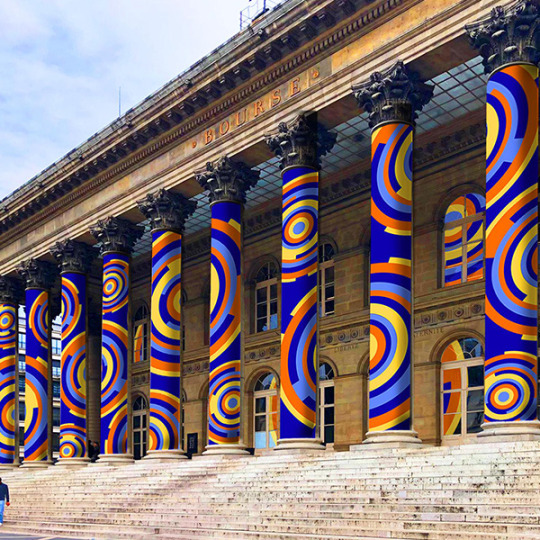
Brongniart died in 1813, so the architect Étienne-Éloi Labarre was put in charge of completing the project. He made some modifications to the original design.
From the Palais Brongniart website:
The Emperor wanted to bring all stock exchange activities together in one place, a real innovation at the time in order to optimize the existing system.
[…] The site will indeed be the lung of 19th-century financial activity, promoting the expansion of railways, steelmaking and major industrial adventures, until 1998, when the stock exchange closed at the Palais Brongniart.
Today, Palais Brongniart is one of the leading congress and event centers in Paris, with a philosophy of action based on economic, social and solidarity innovation. A project led by GL events, one of the international leaders in the management of event spaces, and with the City of Paris, owner of the building.
Sources: (1) (2)
#Palais Brongniart#Palais de la Bourse#napoleon#napoleon bonaparte#Paris#architecture#history#France#napoleonic era#napoleonic#first french empire#19th century#french empire#stock exchange#Alexandre-Théodore Brongniart#Brongniart#Étienne-Éloi Labarre#Labarre#art#design#Corinthian#corinthian columns
6 notes
·
View notes
Photo

🐻🧡 #streetoonours #architecte #ruebrongniart #brongniart #architecture #street #paris 🌈 🎨 #streetart #collageart #streetartparis Inspiration #bisounours #carebears #carebear https://www.instagram.com/p/CgZzd2SD4tC/?igshid=NGJjMDIxMWI=
#streetoonours#architecte#ruebrongniart#brongniart#architecture#street#paris#streetart#collageart#streetartparis#bisounours#carebears#carebear
0 notes
Text
Trilobite of the Day 56
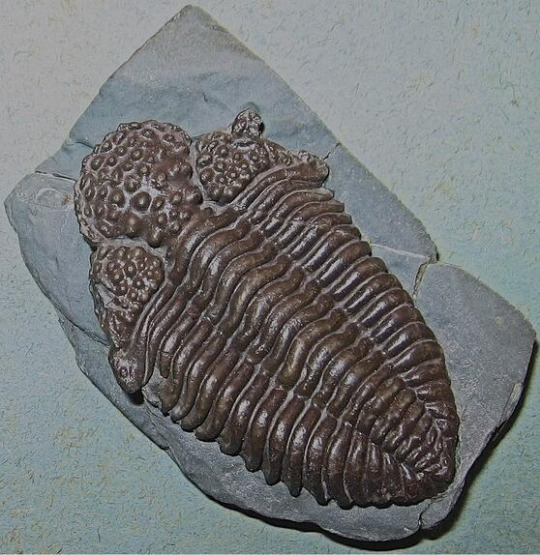
Balizoma cf. variolaris (Brongniart,1822)
Middle Silurian, Wenlockian Stage, Homerian Substage
Much Wenlock Limestone Formation
Wren’s Nest Hill, Dudley, West Midlands, England
4.2 cm
#posting#trans paleontologist#trilobites#paleontology#trilobite of the day#trilobite#invertebrate paleontology#fossils
35 notes
·
View notes
Photo
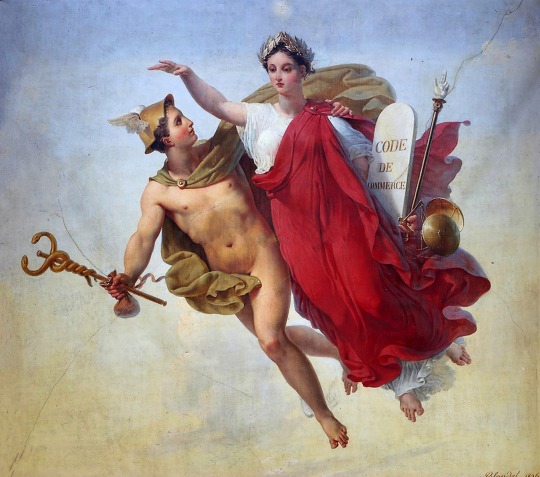
Allegory of Justice Protecting Commerce. 1826. Merry-Joseph Blondel, 1781-1853, ceiling mural in the Salon d'Honneur. Palais Brongniart. http://hadrian6.tumblr.com
160 notes
·
View notes
Text






Green Sea Turtle - The Port A Jetty, East Cotter Avenue, Port Aransas, Texas, USA
Joshua J. Cotten
Scientific name: Chelonia mydas
Conservation status: Endangered (Population decreasing)
Mass: 350 lbs (Adult)
Class: Reptilia
Domain: Eukaryota
Family: Cheloniidae
Genus: Chelonia; Brongniart, 1800
The green sea turtle, also known as the green turtle, black turtle or Pacific green turtle, is a species of large sea turtle of the family Cheloniidae. It is the only species in the genus Chelonia.
Green turtles are found worldwide primarily in subtropical and temperate regions of the Atlantic, Pacific, and Indian Oceans, and in the Mediterranean Sea. In U.S. Atlantic and Gulf of Mexico waters, green turtles are found in inshore and nearshore waters from Texas to Maine, the U.S. Virgin Islands, and Puerto Rico.
#The Port A Jetty#East Cotter Avenue#Port Aransas#Texas#USA#US#United States#United States of America#North America#Turtles#Turtle#Sea Turtle#Green Sea Turtle#Wildlife#TXWildlife#Chelonia mydas#Reptilia#Eukaryota#Cheloniidae#Chelonia
4 notes
·
View notes
Photo





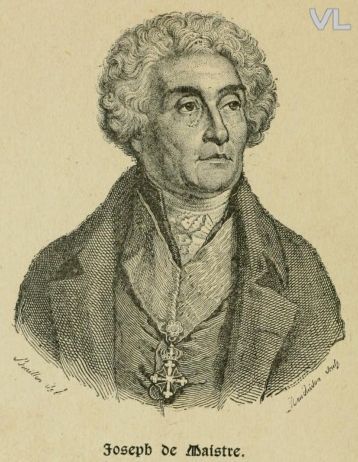
Étienne-Louis Boullée (1728 – 1799) was a visionary French architect whose work greatly influenced contemporary architecture.
It was as a teacher and theorist at the École Nationale des Ponts et Chaussées between 1778 and 1788 that Boullée made his biggest impact, developing a distinctive abstract geometric style inspired by Classical forms. His work was characterised by the removal of all unnecessary ornamentation, inflating geometric forms to a huge scale and repeating elements such as columns in huge ranges.
Boullée's ideas had a major influence on his contemporaries, not least because of his role in teaching other important architects such as Jean Chalgrin, Alexandre-Théodore Brongniart, and Jean-Nicolas-Louis Durand. Some of his work only saw the light of day in the 20th century; his book Architecture, essai sur l'art ("Essay on the Art of Architecture), arguing for an emotionally committed Neoclassicism, was only published in 1953. The volume contained his work from 1778 to 1788, which mostly comprised designs for public buildings on a wholly impractical grand scale.
Boullée's fondness for grandiose designs has caused him to be characterized as both a megalomaniac and a visionary. His focus on polarity (offsetting opposite design elements) and the use of light and shadow was highly innovative, and continues to influence architects to this day. He was "rediscovered" in the 20th century and has influenced recent architects such as Aldo Rossi.
Peter Greenaway's film The Belly of an Architect (1987) concerns a fictitious architect who is staging an exhibition devoted to Boullée's work. The film contains many visual references to Boullée.
https://en.wikipedia.org/.../%C3%89tienne-Louis_Boull%C3%A9e
27 notes
·
View notes
Text

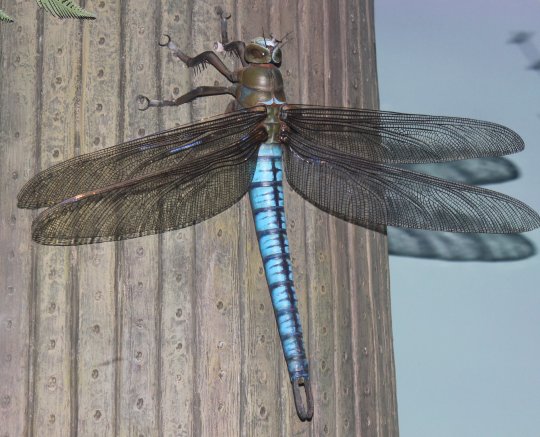


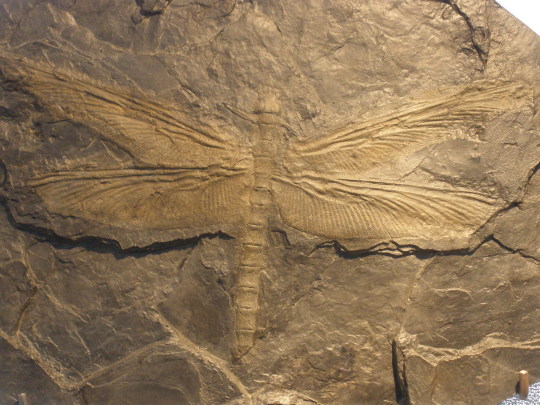


Meganeura
(temporal range: 305-299 mio. years ago)
[text from the Wikipedia article, see also link above]
Meganeura is a genus of extinct insects from the Late Carboniferous (approximately 300 million years ago). They resembled and are related to the present-day dragonflies and damselflies, and were predatory, with their diet mainly consisting of other insects. The genus belongs to the Meganeuridae, a family including other similarly giant dragonfly-like insects ranging from the Late Carboniferous to Middle Permian. With a wingspan ranging from 65 cm (25.6 in) to over 70 cm (28 in),[1][2] M. monyi is one of the largest-known flying insect species.
Fossils of Meganeura were first discovered in Late Carboniferous (Stephanian) Coal Measures of Commentry, France in 1880. In 1885, French paleontologist Charles Brongniart described and named the fossil "Meganeura" (large-nerved), which refers to the network of veins on the insect's wings. Another fine fossil specimen was found in 1979 at Bolsover in Derbyshire. The holotype is housed in the National Museum of Natural History, in Paris. Despite being the iconic "giant dragonfly", fossils of Meganeura are poorly preserved in comparison to other meganeurids.
3 notes
·
View notes
Text
Pere Lachaise Cemetery
As my classmates and I emerged from the metro and began strolling down the street, we soaked up the warm May sun on our skin and took in the noises of the city. We wandered towards Pere Lachaise Cemetery in the 20th arrondissement of Paris, France. As we entered the gate of the cemetery, a wide cobblestone street and a dramatic landscape displayed monstrous gravestones dating back hundreds of years. The gravestones of the winding streets and narrow paths were adorned with moss, engravings, and delicately placed flowers in order to remember the particular lives lost.
While I weaved and wandered through the cemetery, I was particularly struck by the simultaneous beauty and eeriness of my surroundings. The lush trees, bright flowers, uneven cobblestones, and warm sunshine sharply contrasted with the crumbling gravestones, ominous presence of corpses, and cawing of the crows. The intricacy and sheer size of the tombs exceeded anything I had seen before. The beauty of the tombs honored and memorialized the lives of many and recognized their importance. Many individuals sat and read on benches, taking in the solemn peacefulness of their surroundings.
The intersection of characteristics of a somber graveyard and a beautiful park clashed while fitting right into place. I felt uneasy smiling and exploring with friends as some individuals mourned the loss of loved ones. The emergence of Pere Lachaise cemetery as somewhat of a tourist destination and lovely park almost felt insensitive to those who wished to mourn and remember in peaceful silence. The size, significance, and quantity of tombs made me feel small and insignificant as I pondered the perpetuity and non-perpetuity of life itself. An unexpected and overwhelming sense of calm coursed through me as I observed the beautiful resting place of many. As I stood next to the graves of individuals such as Oscar Wilde, Jacques Louis David, and Georges Haussmann, I was amazed by my proximity to individuals that had had an immensely significant impact on the history of France and the world.
As I wandered down a narrow path in the 11th section of the Pere Lachaise Cemetery, I was drawn to a beautiful tomb adorned with wildflowers and overgrown with weeds. The tomb was dedicated to Alexandre Brongniart who was born in Paris on February 5th, 1770, and died on October 7th, 1847. As I conducted a brief Google search on Brongniart, his impact on the world became extremely evident. He filled the roles of a chemist, paleontologist, mineralogist, zoologist, and paleontologist. Brongniart’s work and collaboration with Georges Cuvier on the geology of Paris’ surrounding areas lead to many discoveries. Additionally, he founded the Musée National de Céramique-Sèvres and became the director of the porcelain manufacturing that occurred at Sèvres. Brongniart served as a professor and instructor for many years and spread his knowledge of science and history. His tomb appeared untouched and unmanicured as if lost in time. The mass of tombs allowed many to be mixed in and simply forgotten as tourists bustled past to visit those of more well-known individuals. I would love to return to the cemetery, once again, to take in the diversity of the tombs and the incredible scenery that honors those who have passed (533 words).

2 notes
·
View notes
Text
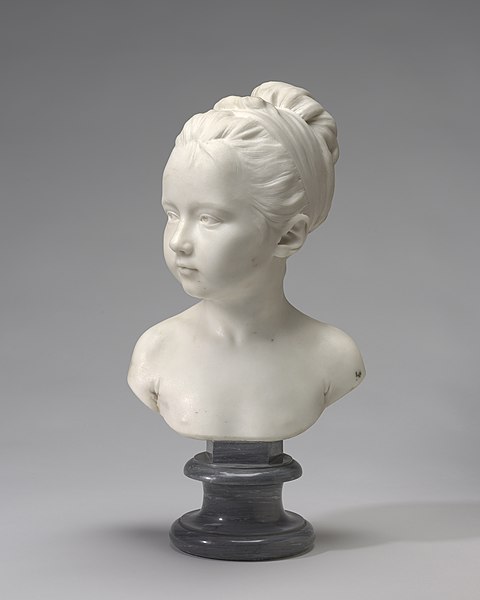
Louise Brongniart, Jean-Antoine Houdon (1741-1828), 1777, marble, National Gallery of Art, Washington
4 notes
·
View notes
Text
Saturday 31 August 1833
7 10
11 25
fine morning – F62° at 8 ¼ am - At my travelling account at 8 ½ to 10 - breakfast at 11 - out with Miss Ferrall at 12 ¾ to 3 ¼ - sauntering about the town and at the printshop - at 3 ¼ took a sort of guide (who could hardly speak a word of French - could hardly make him understand me at all) and went to leave M. Brongniart’s letter and 3 brochures and my own card for Mr. Hausmann professor of mineralogy - M. H- sent down to beg to see me so I walked up and sat 3/4 hour with him - a tall, well-countenanced, agreeable, civil man - asked him about going to the Broken - the time very good but afraid of the weather - no guide-book to be had here in French and afraid I should not meet with anyone who spoke French - but promised me a few hints for my route and would call on me at 11 ½ tomorrow am and if I would be ready at 5 this afternoon, would shew me the botanic garden – then at 4 5 called and sat 1/4 hour with M. Blumenbach (professor celebrated of comparative anatomy) – sent up M. Brongniarts’ letter and my own card – M. B- is above 80 84 but received me with as much vivacity and pleasure and civility as if he had been 30 or 40 years younger – but it was easy to see Nature could not support this exertion for very long – his countenance still fine with an agreeable expression of Goodness – his voice thick – I with difficulty understood his French – said I was English, and found he spoke English much more intelligibly than French and apparently with much more ease – he promised to shew me his cabinet if I would call again at 4 pm tomorrow – I complimented him on his looking so well – he said he minded not long life, but to be useful, that was another thing – his wife older than himself and much more infirm – but he stoops a good deal, has a little rheumatism and is evidently un veillard – then walked on the ramparts till 5 - then to M. Hausmann’s again – he took me to the botanic garden – found he had published his travels in Norway and Sweden about 20 years ago – N- very fine country – said I might travel in Sweden in the winter and it would be very interesting – did not know the contents in superficial measure of the garden – very prettily laid out – fine serres – but said there was nothing particular in them and did not volunteer my going in so I did not – the gardens are partly in the old fosse and this diversity of level is very pretty – did not notice anything very particular – M. H- pointed out some trees planted by [Haller] who was botanical professor here a short while – home at 5 ¾ - dinner at 6 20 in 2 hours – then till 10 20 finished posting account – M. Hausmann said a student might live here for 400 or 500 thalers a year (12 to 15 hundred francs a year?) dearer here than at the little universities of Münden and Marbourg – the lectures here are all paid for but are only a napoleon or 2 par course – fine day – F62° now at 10 20 pm – sadly tired and oppressed with my cold today and yesterday
2 notes
·
View notes
Photo

6 juin 1813 : mort de l’architecte Alexandre-Théodore Brongniart ➽ http://bit.ly/Alexandre-Theodore-Brongniart Par la construction d’un grand nombre d’hôtels, par le dessin élégant de plusieurs jardins, enfin par son habileté dans les arts d’ornements, Alexandre-Théodore Brongniart avait acquis une certaine notoriété lorsqu’il fut chargé par Napoléon, en 1807, de la construction du palais de la Bourse de Paris, dont il ne verra pas l’achèvement mais qui marqua le sceau à sa réputation
#Cejourlà#6juin#Brongniart#architecte#Bourse#Paris#construction#hôtels#jardins#ornements#arts#biographie#histoire#france#history#passé#past#français#french#news#événement#newsfromthepast
7 notes
·
View notes
Text
【Cleaning magic】Comprehensive analysis of dry ice cleaning machines and talk about the magical power to dominate the cleaning field!
Hello everyone, welcome to our blog! Today we will introduce to you a magical equipment that leads the field of cleaning-Dry ice cleaning machine. In this article, you will learn more about what dry ice is, its origins, and the detailed features of a Dry ice blasting machine. At the same time, we will also show you the potential of this technology. Finally, if you are also interested in this cleaning technology, we recommend OLLITAL®'s dry ice pellet machine and Dry ice cleaning machine to you. I will also list for you why you should choose OLLITAL®.

1.What is dry ice?
First, let’s understand what dry ice is. Dry ice, also known as carbon dioxide solid (CO2), is the product of compressing carbon dioxide gas into a solid. In the atmosphere, carbon dioxide gas is compressed into a solid form, forming dry ice.

Dry ice is colorless and odorless. It is a non-toxic and harmless cleaning material and is widely used in various cleaning fields. In the atmosphere, carbon dioxide gas is compressed into a solid form, forming dry ice.The temperature of dry ice is usually minus 78.5 degrees Celsius, which is its sublimation point, that is, the temperature at which it changes directly from solid to gaseous state. Dry ice is in a solid state at room temperature and does not pass through the liquid stage. It directly changes from solid to gaseous state when it sublimates.
Dry ice is mainly used in refrigeration, transportation, and cleaning fields. In the field of cleaning, dry ice impacts the surface of objects through high-speed airflow to achieve a cleaning effect. Dry ice produces a large amount of carbon dioxide gas when it sublimates, which may lead to an increase in carbon dioxide concentration in a closed space. While generally not very toxic, the outgassing from it can cause hypercapnia (abnormally elevated carbon dioxide levels in the blood) due to buildup in confined locations Please pay attention to safety.
2.The origin of dry ice
The history of dry ice can be traced back to the 18th and early 19th centuries, and is related to the discovery and research of carbon dioxide.
- Discovery of Carbon Dioxide: Chemists Joseph Louis Gay-Lussac and Humphry Davy studied carbon dioxide in the late 18th and early 19th centuries. Joseph Louis Gay-Lussac independently discovered carbon dioxide in 1800, Henry Varnon continued to study it after 1800. They noticed that, through specific experiments, carbon dioxide gas could be compressed and liquefied.However, the discovery of carbon dioxide is usually attributed to Scottish chemist Joseph Black, who first discovered it in the 1750s.
- Liquefying Carbon Dioxide: Experiments to liquefy carbon dioxide were conducted in the 1830s. The French physicist and engineer Adolphe Théodore Brongniart performed experiments related to carbon dioxide in 1835, but he did not successfully liquefy the carbon dioxide. After 1835, French engineer Charles Thilorier completed experiments to liquefy carbon dioxide and successfully achieved this. He used high pressure and the right temperature to convert carbon dioxide gas into a liquid state.The first successful liquefaction of carbon dioxide is usually attributed to the efforts of French chemist Charles Cagniard de la Tour in 1822.
- Discovery of Dry Ice: The discovery of dry ice is attributed to French scientists Louis-Joseph Gay-Lussac and Henri Victor Regnault, They noticed that when liquid carbon dioxide was released into the atmosphere, the surrounding air caused rapid cooling and crystallization of the carbon dioxide into a solid state. They observed that these solid forms were similar to ice, but because they did not pass through a liquid state, they were called "dry" ice. In 1824, they successfully prepared dry ice for the first time.However, the term "dry ice" is most commonly associated with American inventor Thomas Benton, who began producing and selling dry ice on a large scale in the early 20th century.
3. Detailed functions of Dry Ice Cleaning machine
Next, let’s take a closer look at the wonders of dry ice blasting. Dry ice cleaning machine is an efficient and environmentally friendly cleaning equipment. Its working principle is to use high-speed spraying of dry ice particles to quickly freeze and crush dirt and grease through the instantaneous alternating hot and cold effect to achieve the purpose of cleaning the surface. Compared with traditional cleaning methods, dry ice cleaning does not produce secondary pollution and does not require cleaning residues. It is suitable for cleaning various complex surfaces and equipment.
- Efficient cleaning: The dry ice cleaning machine can clean the surface of the object in a very short time by spraying small particles of dry ice at high speed. These small particles hit the surface at high speeds during the blasting process, quickly freezing and breaking up dirt, grease, and other contaminants.
- Non-conductive: The cleaning medium of the dry ice cleaning machine is solid carbon dioxide, and dry ice is non-conductive. Therefore, it can be safely used to clean electronic equipment, electrical components and other static-sensitive equipment without causing short circuits or electrical malfunctions.
- No residue: Dry ice sublimates directly into gas during the cleaning process, leaving no moisture or liquid residue. This makes dry ice cleaning suitable for applications that require high cleaning results and no residue, such as food production lines or medical equipment cleaning.
- Environmentally friendly: Dry ice blasting is an environmentally friendly cleaning method because it does not use chemical cleaners and carbon dioxide is a naturally occurring gas in the atmosphere and does not cause harm to the environment. The waste after cleaning is mainly the removed pollutants, and there is no need to process a large amount of chemical waste liquid.
- Suitable for a variety of surfaces: Dry ice cleaning machines are suitable for cleaning a variety of different materials and surfaces, including metal, plastic, rubber, glass, etc. It can be used in many industries such as cleaning machinery and equipment, automobile parts, building surfaces, food processing equipment, etc.
- Reduced downtime: Because dry ice cleaning requires no drying time, cleaned equipment or surfaces can be put into use almost immediately, reducing production line downtime and improving work efficiency.
- Remove difficult-to-clean dirt: Dry ice cleaning has unique advantages for some dirt that is difficult to clean with traditional methods, such as grease, gelatinous substances, pigments, etc. It can quickly freeze these dirt, making it fragile and easy to remove.
youtube
To sum up, the detailed functions of dry ice cleaning machines cover many aspects such as efficient cleaning, non-conductivity, no residue, environmental protection, suitable for a variety of surfaces, reducing downtime, etc., making it widely used in various industries.
4. What can the dry ice cleaning machine be used for?
Dry ice cleaning machine is a multi-functional cleaning tool suitable for multiple industries and application scenarios. The following are common uses for dry ice cleaning machines:
· Industrial equipment cleaning: Dry ice cleaning machines can be used to clean various types of industrial equipment, including mechanical parts, production line equipment, engines, pumps and valves, etc. It effectively removes grease, dirt and other contaminants without damaging equipment surfaces.
· Car maintenance: Dry ice cleaning machine can be used for car maintenance and cleaning, cleaning engine compartment, wheels, chassis and other parts. Due to the non-conductive nature of dry ice, electrical components and sensors can be safely cleaned without causing electrical malfunctions.
· Food and catering equipment cleaning: Dry ice cleaning is suitable for cleaning food production lines and catering equipment. It can remove residual food particles, grease and bacteria and ensure that the equipment meets hygienic standards.
· Building surface cleaning: Dry ice cleaning machine can be used to clean building surfaces, including walls, floors, beams and columns, etc. It effectively removes paint, coatings, stains and other contamination without causing damage to the surface.
· Electronic Equipment Cleaning: Due to the non-conductive nature of dry ice, dry ice cleaning machines can safely clean electronic equipment, circuit boards, computer equipment, etc., removing dust and dirt and improving equipment performance and reliability.
· Aerospace industry: Dry ice blasting is also widely used in the aerospace industry for cleaning aircraft engines, aviation parts and ground equipment. It effectively removes oil and residue from engines without causing mechanical wear.
· Art and Relic Protection: Dry ice blasting machines are used for the cleaning and protection of art and relics because of their ability to gently and efficiently remove contaminants from surfaces without causing damage to the artwork.
· Stone and sculpture cleaning: Dry ice cleaning can be used to clean stone surfaces and sculptures to remove surface dirt, algae, moss, etc., and restore the original appearance of the stone.

Overall, dry ice blasters excel at cleaning and removing contaminants and are suitable for use across multiple industries, increasing cleaning efficiency and reducing environmental impact.Now that we have learned about the power of dry ice cleaning machines, are you also interested in this amazing cleaning technology? If you are also interested in this great cleaning technology, I will introduce OLLITAL®’s high-quality products to you!
OLLITAL® has been specialized in the cleaning industry for decades and has become a leader in the cleaning industry. The company has a variety of cleaning equipment such as: dry ice blast cleaning machines, Dry Ice Granulators, Plasma cleaning machines, Laser cleaning machines, Ultrasonic Cleaning Machines, One-stop service R&D, production, sales and service of related supporting equipment such as. OLLITAL® can develop machines according to customer needs and provide one-stop service for dry ice cleaning technology. Dry ice cleaning machine is an efficient, environmentally friendly and safe cleaning method, which is widely used in molds, machinery, circuit boards and other industries. Dry ice cleaning can only be achieved with proper control of nozzle design, pressure control, cleaning agent control and operating techniques. Ice cleaning machine achieves maximum cleaning efficiency. OLLITAL®'s efficient, environmentally friendly, safe and flexible cleaning equipment has won a good reputation in the industry and has been sold to more than 30 countries around the world. As labor management costs and land costs continue to increase, automated equipment will inevitably replace semi-automatic or manual production in the future. This is the trend of social development. In the face of opportunities and challenges, Lingtie will not forget its original intention and keep moving forward.

OLLITAL® is committed to the research, development and application of dry ice technology and has advanced dry ice granulator machinery and efficient dry ice cleaning machines. Choose our products and you will enjoy:
· Environmental protection and energy saving: Our products are committed to environmental protection and energy saving. During the production and cleaning process, we use advanced processes and technologies to minimize energy consumption and reduce waste emissions, making your production more sustainable.
· Customized Solutions: We offer flexible custom designs to meet your unique needs. Whether it is the special requirements of the production line or the personalized needs of the cleaning scene, we can provide you with exclusive solutions to ensure that the product is perfectly adapted to your business.
· Safe and reliable: Our products undergo strict quality control to ensure stability and reliability. During use, you can operate with confidence, reduce the risk of equipment failure, and improve work efficiency.
· Multi-industry applications: Our products are widely used in multiple industries, including industry, automotive, food, medical and other fields. No matter what your business type is, we can provide you with practical solutions to meet your diverse needs.
· Professional training and support: Choose our products and you will receive professional training and support services. Our team will provide you with detailed product training to ensure you fully understand the operation and maintenance of the product, while our after-sales service team will be at your disposal to solve problems and provide support.
· Global Quality Recognition: Our products comply with international standards and have gained a good reputation worldwide. By choosing our products, you will get the guarantee of global quality recognition, providing reliable support for the steady development of your business.
If you want to know more about Dry Ice Pellet Manufacturing Machinery or you want to build a dry ice production line, please refer to [Dry Ice Production Demystified: Go Behind the Scenes and Uncover the Magic of Pelletizers].
In this era of cleaning revolution, choose a dry ice cleaning machine to make cleaning easier, more efficient and more environmentally friendly! Thank you for reading our blog, if you have any questions or cooperation intentions, please feel free to contact us. Let us help the cleaning industry together and create a better future!
0 notes
Text


Through the Years → Maria Teresa, Grand Duchess of Luxembourg (477/∞)
28 November 2023 | The Grand Duchess participated, at the Palais Brongniart in Paris, in the 18th “Women’s Forum Global Summit”. (Photo by Sophie Margue/Maison du Grand-Duc)
#Grand Duchess Maria Teresa#Luxembourg#2023#Sophie Margue#Maison du Grand Duc#through the years: Maria Teresa
0 notes
Text
References évènements
2 ans à me produire tous les soirs comme meneuse de revue pour le diner spectacle du (cabaret PAU CARAIBES et PAU BRASIL sur les Champs-Elysées )
Elysée Montmartre, New Morning, Zenith de Paris.
Mariage de Andrea Casiraghi, fils aîné de la princesse Caroline de Monaco, avec Tatiana Santo Domingo en suisse, 2014. Concert pour la cérémonie avec le pianiste cubain Roberto Fonseca, plusieurs fois nominé au Grammy Awards.
Forum économique mondial de Davos 2015 , Animation des événements de la FFF pour la coupe du monde de football en 2002 et 2014, Woman’s international forum de Deauville 2014 ,Finale de la Coupe du monde de football 2002, Coupe du monde de Rugby 2007,Stade de France, Parc des princes, Rolland Garros ,hippodrome de Vincennes...
4 Tournées Norvège, 4 Tournées Arabie Saoudite (Pour Ambassade et consulat Français), 5 Tournées Emirats arabes unis, Tournée Europe, Danemark, Suède, Tournées Maroc
Inauguration de l’hôtel Hilton de Doha (Qatar) , Emirates Palace (Dubai), Restaurant Maxim's, Pavillon le Doyen, Pavillon Dauphine, Pavillon d'Armenonville, Palais des congrès de Paris,le Georges V, Pré Catelan, Hôtel de Paris (Monaco), Palace hôtel (Gstaad Suisse),Pavillon Gabriel, Palais Brongniart, Pavillon Baltard , Villa Carmen, Carrousel du Louvre, Pavillon lenôtre, Pavillon Royal, Cap Gemini, Neuflize vie ,Le Trianon, L'étoile, la Rhumerie, Relais du bois de Boulogne, La closerie des Lilas, Mairie de Paris, Zenith D'Orleans, le Cabaret Sauvage,
Casinos (Deauville, Enghien les Bains, Yport, Luc sur Mer, Pougues les Eaux, Montrond les Bains, Villers sur Mer, Roscoff, Dunkerque, Chatelayon, Ste Maxime, Allevard, Spa, Mondorf les Bains, Chambery, Aix les bains, Challes les eaux…)
Cartier, Guerlain, Rolex, PSA, Louis Vuitton, Patek Philippe, General Electric, Porsche, Mercedes, Opel, Toyota, Lexus, Volvo,Toyota ,Peugeot, Altran, AGF, Maaf, KPMG, Ariane Espace, Beneteau, Ingenico, Arcelor, Moët & Chandon, Pernot Ricard, Dalloyau, Microsoft, Club Méditerranée, le MEDEF, CGT, IPSEN, Clearstream,Bally, Vinci, Bally, Area, The Phone House, Sanofi ,Toal, Valeo ,Hachette Filipacchi , Lagardère active, Gaselys , CAPSTAN,Synthelabo, Morpho-Saphran, Sanofi- Aventis ,France Telecom, Bouygues Telecom, Groupe Accor, LG, Reynolds, Gallaher, Benson & Edge, Euro RSCG, CCB Belgique, Geodis, Imerys, Sodexho, Pioneer, Generali, AREVA, Arcelor, Carmeuse, Gemey La route du rhum, Soirées des responsables des bourses internationales (Wall street, Tokyo...), CNP, Bricodepo, JP Morgan, Water house coopers service,Marsans, Banque populaire Occitane, Caisse des dépôts et consignation, Total, BASF ,Glavelberg, Crédit Agricole, Banque Rhône Alpes,HSBC, Banque populaire du Nord, Société générale, Pictet & Cie,CNRS, Unesco,Lenovo, RATP, Air France, Stars airline, Aéroport de Liège, Aéroport de Bruxelles, Les fêtes de Genève, ADP, Yachts de Paris , Foire de Paris, conseil régional de la Somme, Salon de l'agriculture, musée des arts forains, Marathon de Paris,La croix rouge, Mairies, Soirées privées, etc...
0 notes
